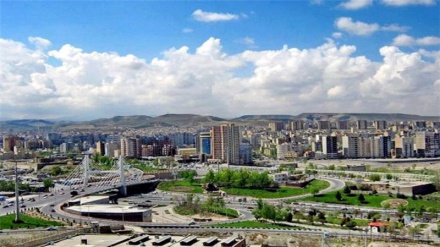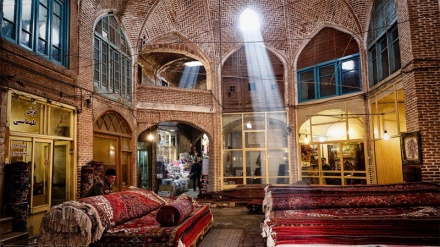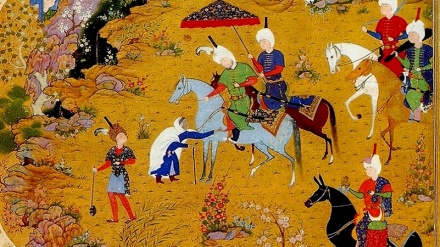Tabriz, 2018 (14)
Welcome to this week's episode of the series "Tabriz, 2018". Today, we become familiar with some of the historical monuments of the Iranian city of Tabriz.
Every given city maintains its own history and identity, and is home to works and monuments which manifest that city's background. Tabriz in home to several historical monuments. By visiting the heart of this city, one observes several historical monuments. Each of these buildings are reminders of Iran's history, and are highly attractive for the visiting tourists. Alishah Citadel, which dates back to 700 years ago, is one of the longest and oldest historical walls in Iran, and is known as one of the most important tourist attraction sites, across the country.
This unique complex was initially constructed in the form of a large mosque, which has been largely damaged throughout the years, in the wake of several earthquakes that rocked this city, and the battles which broke out in Tabriz. Currently, the only remaining part of this complex is a tall wall, which is popularly known as Alishah Citadel. The remains of this building are in the form of three walls, which appear in the shape of a balcony. The width of each of these walls is ten meters, and this citadel's inner section is in fact comprised of two wide walls, which are bonded to each other with arcs. Meanwhile, throughout the excavations, it has been discovered that seven meters of these walls are located beneath soil.
In other words, this wall is the only remains of the huge walls, and the Mehrab of the southern roofed section of this mosque, bearing witness to the grandeur of this unique building. The construction of the initial building of this mosque was carried out as of 716 AH to 724 AH upon the initiative of the Ilkhanid vizier, Taaj Ed-Din Alishah Gilani, with the intention of construction of a large tomb at the mosque's courtyard. According to historians; the southern section of this mosque maintained a large arc. Meanwhile, the death of Alishah was one of the causes of a halt in the construction of this building in that phase in time.
Upon a glance at this 700-year-old historical monument, it can be realized that Alishah Citadel is a valuable legacy of the historical developments which have taken place. This building, based on the features of each phase in time, had maintained different applications. For instance, in the Qajarid era, this mosque and its courtyard turned into a grain warehouse, and a store of military equipment. Hence, it was surrounded by a fence, and was renamed a citadel.
Upon the break out of Iran-Russia wars throughout the years 1804-1824, and Iran-England battle in the year 1857, Alishah Citadel turned into a military citadel. Upon the instruction of the Qajarid Crown Prince, Abbas Mirza, two important military organizations, including a garrison were constructed at the Citadel's courtyard.
Throughout the Constitutional Revolution, and the uprising of the people of Tabriz, this historical monument turned into the bastion of Constitutionalists, and reinforced the position the forces of renowned Constitutionalists, Sattar Khan and Baqer Khan, in the face of the artillery fire of the troops of Qajarid King, Mohammad Ali Shah. In the era after the Constitutional Revolution, people of Tabriz stood up against the incursions of the Russian army; with Alishah Citadel once again turning into the solid bastion for the defenders of this city. In the solar Iranian calendar year of 1290, upon the fall of Tabriz, and its occupation, the Russian forces targeted Citadel's wall with artillery fire. Meanwhile, throughout the Constitutional Revolution, and thereafter, a number of other buildings such as one of the first modern schools in Iran, and a theater hall, were constructed at the Citadel's courtyard.
In the years prior to victory of Islamic Revolution, the courtyard of Alishah Citadel had turned into an orchard, and currently the courtyard of this historical monument is used as a prayer ground.
Due to numerous destructions, there is no clear picture of the initial and complete shape of this complex. However, this huge building has been described in the majority of travelogues, and writings of well-known historians.
This valuable historical monument was enlisted among Iran's national heritages in the year 1931.
An important part of Iran's historical monuments, are the historical mosques. The Jame'h Mosque of any given city is, generally speaking, the first historical monument of that town. Jame'h Mosque of Tabriz is considered as one of the valuable historical buildings of this city. In addition to its architectural beauty, this mosque maintains an ancient history, dating back to Saljuqid era. In the year 1931, this mosque was enlisted among Iran's national heritages.
The oldest part of this mosque is its roofed section, which maintains an arc and domes standing on brick-made octagonal columns that are covered with delicate and artistic forms of plasterworks, dating back to Saljuqid era. This mosque was of significant importance in the Ilknanid era. It has been renovated, with a number of new sections added to this historical mosque.
The current mosque is the result of renovations and reconstructions which have been carried out throughout the Qajarid era.
MR/ME


